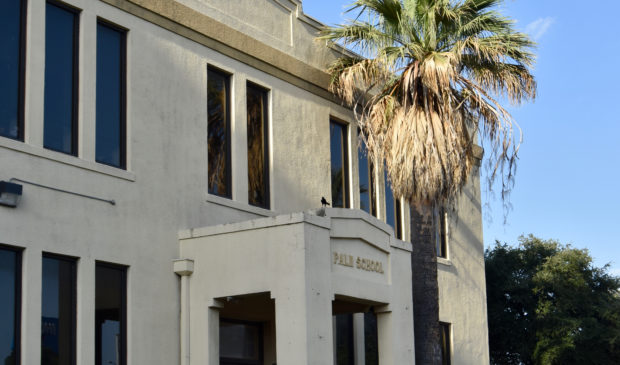Commissioners debate future of Palm School property
Wednesday, October 9, 2019 by
Jack Craver Four months after voting to put in place restrictions on the Palm School property that would prevent the main building from being redeveloped, members of the Travis County Commissioners Court continue to display differences of opinion about the property’s future.
On Tuesday, county staff presented the court with the results of a month of community input on the property’s future. Of the 250 emails from residents, explained Allison Fink of the Economic Development and Strategic Investments Department, all but 10 were in favor of some form of preservation. Some supported the plan endorsed by the commissioners to preserve the historic building while others said they were against any redevelopment on any part of the property.
In June the commissioners voted unanimously in favor of drafting a restrictive covenant that would commit any future owner of the property to preserving what is considered the historic part of the building. The covenants would not prevent a future owner from redeveloping newer parts of the building – some additions are as recent as the 1980s – or the rest of the property.
County Judge Sarah Eckhardt has described the restrictive covenants as a way to ensure the preservation of a historic structure while allowing the county to sell the property for tens of millions of dollars, a particularly attractive prospect as the county enters an era of state-imposed tax constraints. An appraiser estimated the property could fetch over $50 million on the market, despite the significant development restrictions.
On Tuesday Commissioner Gerald Daugherty said he didn’t believe the county would be able to realize nearly what the appraisal suggested due to all of the strings attached to the purchase. The covenants not only require the buyer to keep the building in place, but to spend millions to restore it to its original historic character after decades of wear and tear.
“I think we’re moving quickly toward a place where this thing is going to be worth nothing,” he said.
The commissioners are scheduled to hear more public input on Oct. 22. The following week, they will take a final vote. That means there is still a chance the court could be swayed by public input to change the terms of the covenants or to abandon the idea of selling the property altogether.
Daugherty said he expects a packed room of preservation supporters at the Oct. 22 meeting and predicted that the “vast majority” of them will oppose allowing the county to sell the property at all.
“I think that’s sad for the Travis County taxpayer because we’re fixing to start cutting things that we can’t fund,” he said, referring to other county programs that may be on the chopping block due to the recently imposed revenue restrictions.
Commissioner Brigid Shea was more optimistic.
“I disagree with Gerald,” she said. “I think we are respecting the community’s desire to protect the historic building, and very tiny plots of land downtown have enormous value. So the portion of that lot that doesn’t have the historic building and doesn’t have the setback protections has value.”
Eckhardt, acknowledging the public input, said she believed the majority of her constituents would not want the county to forgo $50 million of revenue. That’s enough money, she noted, to knock 2 cents off the county’s property tax rate.
Commissioners Jeff Travillion and Margaret Gómez, however, stressed the importance of preserving a property that is significant to the history of the Mexican American community in Austin.
Travillion said it’s a “crying shame” how many historic buildings are no longer there “when you drive down East 11th or East 12th Street.”
“Communities of color have been moved around throughout Austin,” said Gómez. “They get in the way and they are moved out of the way so the area can develop, and in the process we erase them from our memories.”
A group of activists pushing for the preservation of the former school has said the entire property should remain publicly owned.
At this point, no commissioner has come out against selling the land to a developer and allowing parts of the land to be redeveloped. However, Eckhardt and Daugherty have been unambiguous about their desire to get as much money from the land as possible, while Gómez has suggested the city and county cooperate to keep the property in the public realm.
On Tuesday most of them agreed that the county had plenty of time before it needs to make a sale. The county will be using the Palm School building through 2021.
“I’m willing to hold on for a while,” said Travillion, referencing potential buyers. “I can wait longer than they can wait.”
Photo by Nick Amoscato made available through a Creative Commons license.
The Austin Monitor’s work is made possible by donations from the community. Though our reporting covers donors from time to time, we are careful to keep business and editorial efforts separate while maintaining transparency. A complete list of donors is available here, and our code of ethics is explained here.
You're a community leader
And we’re honored you look to us for serious, in-depth news. You know a strong community needs local and dedicated watchdog reporting. We’re here for you and that won’t change. Now will you take the powerful next step and support our nonprofit news organization?









